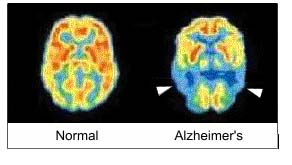The symptoms of very early stage Alzheimer’s Disease are similar to the symptoms from other forms of dementia, chronic depression, and even normal aging. PET/CT is the most accurate tool for differentiating Alzheimer’s Disease from these other causes.
Furthermore, PET/CT can diagnose Alzheimer’s Disease in its very early stage, long before there is significant loss of mental capacity.
Being able to accurately diagnose Alzheimer’s Disease at a very early stage has some important benefits. First, the patient can start taking drugs which will slow the progression of the disease. Second, it will give the patient time to make future plans before he/she experiences significant loss of mental capacity.
Also, if PET/CT shows that the symptoms are not due to Alzheimer’s Disease then your doctor will continue the diagnostic work-up to find the true cause of the symptoms, which will help the doctor choose the most appropriate therapy.
How PET/CT Works in Alzheimer’s Disease
Normal brain tissue consumes lots of sugar to supply the energy needed for it to function. The area that uses the most sugar is the outer edge, called the cortex. In early stage Alzheimer’s Disease, function in very specific regions of the cortex starts to decline. This shows up as a reduction in sugar consumption in those regions. PET/CT is able to make images of sugar consumption (shown below). This is why it is so effective at diagnosing Alzheimer’s Disease.

More Information

